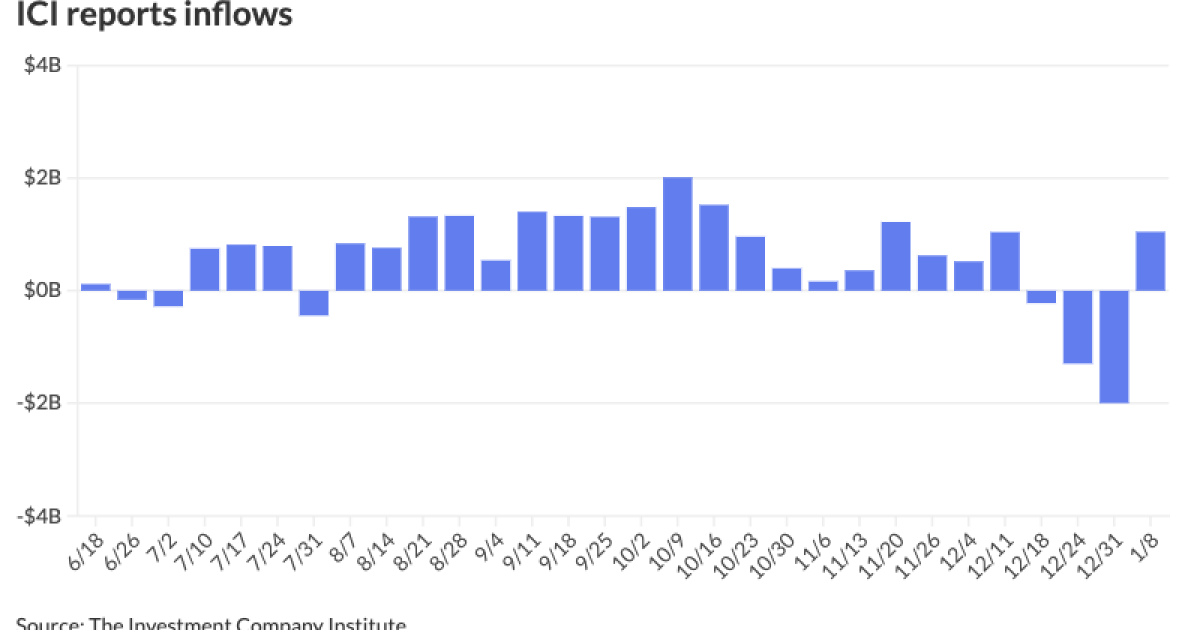Muni yields fall, but underperform UST rally following CPI report
8 min read
Municipals improved Wednesday amid a large new-issue slate, though underperformed a U.S. Treasury rally, after the consumer price index showed a slowdown in inflation.
The CPI came in below expectations, while the core CPI, which strips out the more volatile costs of food and energy, was softer than expected.
“A first decline in the 12-month core rate … was greeted well by a bond rally initially lowering the yield on the benchmark 10-year Treasury note to its lowest reading in nearly a week,” noted Gary Schlossberg, a Wells Fargo Investment Institute market strategist,
But the single report won’t greatly change monetary policy expectations, with a rate cut unlikely through spring, he said.
“We believe it likely will take several months of slowing inflation to get the Fed — and the market — thinking about another rate cut.”
However, the data removed some worry about the possibility of a “rate hike in response to inflation stoked by resilient growth and worries over the inflationary impact of Trump’s trade and immigration policies,” he added.
UST yields fell up to 15 basis points and munis followed with yields lowered by two to six basis points, depending on the scale.
The better session marks a departure from the selloff from the end of the year through mid-January, said JB Golden, executive director and a portfolio manager at Advisors Asset Management,
The market is resetting expectations on monetary policy and the value of munis versus Treasuries, he noted.
The two-year municipal to UST ratio Wednesday was at 67%, the five-year at 67%, the 10-year at 69% and the 30-year at 83%, according to Municipal Market Data’s 3 p.m. EST read. ICE Data Services had the two-year at 66%, the five-year at 64%, the 10-year at 66% and the 30-year at 80% at 4 p.m.
Municipals are underperforming USTs month-to-date, with the Bloomberg Municipal Index showing losses of 1.02% versus 0.92% for USTs as of Tuesday, but both are outperforming losses in corporates that are seeing 1.23% losses in January.
The Investment Company Institute reported inflows for the first week of 2025, with investors adding $1.046 billion for the week ending Jan. 8, following $1.997 billion of outflows the previous week.
Exchange-traded funds saw inflows of $369 million after inflows of $541 million the week prior, per ICI data.
This week saw several large deals come to market, including the Triborough Bridge and Tunnel Authority with $1.3 billion of MTA Bridges and Tunnels real estate transfer tax revenue bonds, the Orlando Health Obligated Group with $1.225 billion of hospital revenue bonds in two deals and the Airport Commission of the city and county of San Francisco with $984 million of San Francisco International Airport second series revenue bonds.
There are other billion-plus deals on the calendar through the end of the month, including the University of California with up to $2.5 billion of general revenue bonds, the Oklahoma Turnpike Authority with $1.3 billion of turnpike system second senior revenue bonds, around the Columbus Regional Airport Authority with $1 billion of revenue bonds and the state of Washington with $1.2 billion of GOs.
There is also $2.5 billion of senior subordinated secured revenue bonds for the Brightline West Passenger Rail Project on tap.
Mega deals allow more participants into the market and add liquidity to the market, Golden said.
“All of a sudden, you can start buying some CUSIPs and allocations amongst portfolios,” he noted.
Bond Buyer 30-day visible supply sits at $12.88 billion.
In the primary market Wednesday, Siebert Williams Shank held a one-day retail order for the Triborough Bridge and Tunnel Authority’s (A1/A+//AA/)
Morgan Stanley accelerated a pricing for the Orlando County Health Facilities’ (/A+/AA-/) $853.08 million of Orlando Health Obligated Group hospital revenue bonds, Series 2025A, with 5s of 10/2038 at 3.76%, 5s of 2040 at 3.92%, 5s of 2045 at 4.35%, 5s of 2047 at 4.48%, 4.5s of 2056 at 4.75% and 5.25s of 2056 at 4.61%, callable 4/1/2035.
J.P. Morgan priced for the Idaho State Building Authority (Aaa//AA+/) $310.59 million of school modernization facilities fund sales tax revenue education bonds, Series 2025A, with 5s of 6/2025 at 2.85%, 5s of 2030 at 3.08% and 5s of 2034 at 3.28%, noncall.
BofA Securities priced for the Indiana Municipal Power Agency (A1/AA/A+/) $256.91 million of power supply system revenue bonds, Series 2025A, with 5s of 1/2026 at 3.02%, 5s of 2030 at 3.26%, 5s of 2035 at 3.58%, 5s of 2040 at 3.94% and 5s of 2043 at 4.10%, callable 1/1/2035.
J.P. Morgan priced for the city of
BofA Securities priced for the Iowa Finance Authority (/AAA/AAA/) $165.89 million of state revolving fund green revenue bonds. The first tranche, $146.715 million of tax-exempts, Series 2025A, with 5s of 8/2030 at 3.04%, 5s of 2035 at 3.34%, 5s of 2040 at 3.68%, 5s of 2045 at 4.09%, 5s of 2050 at 4.26% and 5s of 2054 at 4.35%, callable 2/1/2035.
The second tranche, $14.985 million of taxables, saw all bonds at par: 4.44s of 8/2027 and 4.63s of 2029, noncall.
In the competitive market, the Iowa Board of Regents sold $252.665 million of University of Iowa Healthcare hospital system revenue bonds, Series 2025A, to BofA Securities, with 5s of 9/2026 at 3.00%, 5s of 2030 at 3.20%, 5s of 2035 at 3.52%, 5s of 2040 at 3.84%, 4.375s of 2045 at 4.468% and 4.75s of 2050 at 4.625%, callable 9/1/2034.
CUSIP requests fall
The aggregate total of identifier requests for new municipal securities — including municipal bonds, long-term and short-term notes, and commercial paper — fell 13.3% versus November totals. On a year-over-year basis, overall municipal volumes were up 9.0%.
Texas led state-level municipal request volume with a total of 76 new CUSIP requests in December, followed by New York (73) and New Jersey (62).
For municipal bond identifier requests specifically, there was a drop of 9.8% month-over-month, but requests for these securities were up 9.0% for 2024 overall.
AAA scales
MMD’s scale was bumped two to four basis points: The one-year was at 2.84% (-2) and 2.87% (-2) in two years. The five-year was at 2.96% (-3), the 10-year at 3.20% (-4) and the 30-year at 4.07% (-4) at 3 p.m.
The ICE AAA yield curve was bumped three to five basis points: 2.84% (-3) in 2026 and 2.88% (-3) in 2027. The five-year was at 2.94% (-4), the 10-year was at 3.17% (-4) and the 30-year was at 3.99% (-5) at 4 p.m.
The S&P Global Market Intelligence municipal curve was bumped three to five basis points: The one-year was at 2.84% (-5) in 2025 and 2.86% (-4) in 2026. The five-year was at 2.92% (-4), the 10-year was at 3.13% (-3) and the 30-year yield was at 3.99% (-3) at 4 p.m.
Bloomberg BVAL was bumped three to six basis points: 2.79% (-3) in 2025 and 2.85% (-3) in 2026. The five-year at 2.98% (-4), the 10-year at 3.23% (-5) and the 30-year at 4.04% (-6) at 4 p.m.
Treasuries rallied.
The two-year UST was yielding 4.27% (-10), the three-year was at 4.341% (-13), the five-year at 4.447% (-15), the 10-year at 4.653% (-14), the 20-year at 4.945% (-12) and the 30-year at 4.873% (-11) at the close.
CPI
The below-expectations read on the consumer price index kept alive the possibility of a rate cut this year, analysts said, setting up “a favorable trading day.”
“This is exactly what the bulls on Wall Street were hoping for,” said Jochen Stanzl, chief market analyst at CMC Markets. “The decline in core inflation is a relief, even if core inflation is still well above the Fed’s 2% target.”
With the Federal Reserve saying it would be cautious about further rate cuts, the report “is confirmation that the Fed is right … especially as there are no signs of concern on the jobs market,” he said.
“However, there is at least some hope that the only rate cut still hoped for in 2025 will not vanish,” Stanzl added.
The key takeaway, according to Tina Adatia, head of fixed income client portfolio management at Goldman Sachs Asset Management, is it “should help cool fears of a reacceleration in inflation.”
And while there won’t be a January rate cut, the data “strengthens the case that the Fed’s cutting cycle has not yet run its course. With labor market data remaining robust, however, the Fed has scope to be patient and more good inflation data will be required for the Fed to deliver further easing.”
Jeff Schulze, head of economic and market strategy at ClearBridge Investments, agreed the report “should help allay near-term investor concerns about a reacceleration in prices as stronger economic data and a hot jobs report left many questioning whether progress would continue on the inflation front.”
CPI confirms “rate cuts are off-season, at least for a while,” said Giuseppe Sette, president of Reflexivity. But the strength in the labor market means “fewer rate cuts and higher rates,” he said.
“The takeaway is that not much has changed: a Republican pro-market presidency, strong momentum, AI acceleration are all here to stay,” he said. “Use the dip as a buying opportunity.”
If CPI is soft next month and payrolls weaken, a March rate cut may be considered, said Seema Shah, chief global strategist at Principal Asset Management. “Perhaps the key takeaway is that markets are likely to be whipsawed over the next few data releases as investors seek a narrative that they can be comfortable with for more than just a few days at a time.”
The Fed needs to continue fighting inflation, noted BMO Senior Economist Sal Guatieri, “which is why it has shifted plans to more slowly reduce the still-restrictive federal funds rate.”
The Fed could stay on hold, he said, “until it gets some clarity on the inflation pass-through of the tariffs that could begin rolling out next week.”
The markets are now pricing in about 40 basis points of rate cuts this year, noted ING Chief International Economist James Knightley, “but 10Y Treasury yields are 10bp lower.”
While ING still expects three cuts this year, they may begin in June rather than March, he said.
“While the market is still wary of the incoming administration’s policies especially around tariffs and tax cuts which could help to stoke inflation, this morning’s inflation numbers go a long way to giving the market confidence that Fed policy is on target,” said John Kerschner, head of U.S. securitised products and portfolio manager at Janus Henderson Investors.
Still, progress on “inflation has seemed to effectively stall in recent months,” said Wells Fargo Securities senior economists Sarah House and Michael Pugliese. Core CPI rose at an annualized rate of 3.3% over the past three months, up slightly from 3.2% over the six-month and 12-month rates, they noted.
“The sideways move in core inflation in recent months comes as deflation in core goods has faded since the summer and offset the frustratingly slow pace of services disinflation,” House and Pugliese said.
As a result, they now see two rate cuts (in September and December), one fewer than they did at the start of 2025.
“The details [of the report] were consistent with continued, if slow, disinflation,” said the BNP Paribas Markets 360 team. “Non-shelter services and non-vehicle core goods drove the bulk of moderation compared to the prior month.”
BNP expects no rate cuts this year, “based on an inflationary upsurge from the new administration’s policies.”
Primary to come
The Plano Independent School District, Texas, (Aaa/AAA//) is set to price Thursday $607.3 million of PSF-insured unlimited tax school building bonds, serials 2026-2045. RBC Capital Markets.
The Idaho State Building Authority (Aaa//AA+/) is set to price Thursday $310.59 million of school modernization facilities fund sales tax revenue education bonds. J.P. Morgan Securities.
The Regents of the University of Colorado (Aa1//AA+/) is set to price Thursday $300 million of Series 2025A university enterprise revenue bonds and Series 2025B refunding university enterprise revenue bonds. Wells Fargo.







